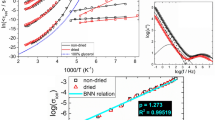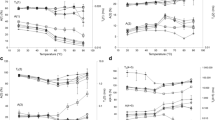Abstract
Purpose
This study explored the potential of combining the use of moisture sorption isotherms and dielectric relaxation profiles of starch and sodium starch glycolate (SSG) to probe the location of moisture in dried and hydrated samples.
Methods
Starch and SSG samples, dried and hydrated, were prepared. For hydrated samples, their moisture contents were determined. The samples were probed by dielectric spectroscopy using a frequency band of 0.1 Hz to 1 MHz to investigate their moisture-related relaxation profiles. The moisture sorption and desorption isotherms of starch and SSG were generated using a vapor sorption analyzer, and modeled using the Guggenheim-Anderson-de Boer equation.
Results
A clear high frequency relaxation process was detected in both dried and hydrated starches, while for dried starch, an additional slower low frequency process was also detected. The high frequency relaxation processes in hydrated and dried starches were assigned to the coupled starch-hydrated water relaxation. The low frequency relaxation in dried starch was attributed to the local chain motions of the starch backbone. No relaxation process associated with water was detected in both hydrated and dried SSG within the frequency and temperature range used in this study. The moisture sorption isotherms of SSG suggest the presence of high energy free water, which could have masked the relaxation process of the bound water during dielectric measurements.
Conclusion
The combined study of moisture sorption isotherms and dielectric spectroscopy was shown to be beneficial and complementary in probing the effects of moisture on the relaxation processes of starch and SSG.









Similar content being viewed by others
Abbreviations
- ANOVA:
-
Analysis of variance
- ATR-FTIR:
-
Attenuated total reflectance Fourier transformed infrared
- AUC:
-
Area under the curve
- aw :
-
Water activity
- D :
-
Thickness of the adsorbed moisture
- Δε:
-
Dielectric strength
- GAB:
-
Guggenheim-Anderson-de Boer
- HW :
-
Hydrated water
- r :
-
Radius of the capillary
- RH:
-
Relative humidity
- SEM:
-
Scanning electron microscope
- SSG:
-
Sodium starch glycolate
- τmax :
-
Relaxation time
- VSA:
-
Vapor sorption analyzer
References
Moreton CR. Disintegrants in tableting. In: Augsburger LL, Stephen HW, editors. Pharmaceutical dosage forms: tablets. Boca Raton: CRC Press; 2008. p. 217–50.
Schwartz JB, Zelinskie JA. The binding and disintegrant properties of the corn starch fractions: amylose and amylopectin. Drug Dev Ind Pharm. 1978;4(5):463–83.
Augsburger LL, Brzeczko AW, Shah U, Hahm HA. Super disintegrants: characterization and function. In: Swarbrick J, editor. Encyclopedia of pharmaceutical technology. 3rd ed. Boca Raton: CRC Press; 2006. p. 3553-67.
Bolhuis G, van Kamp H, Lerk C. Effect of variation of degree of substitution, crosslinking and purity on the disintegration efficiency of sodium starch glycolate. Acta Pharm Technol. 1984;30(1):24–32.
Khan KA, Rhodes CT. Water-sorption properties of tablet disintegrants. J Pharm Sci. 1975;64(3):447–51.
Zhao N, Augsburger LL. The influence of granulation on super disintegrant performance. Pharm Dev Technol. 2006;11(1):47–53.
Gordon MS, Chowhan ZT. The effect of aging on disintegrant efficiency in direct compression tablets with varied solubility and hygroscopicity, in terms of dissolution. Drug Dev Ind Pharm. 1990;16(3):437–47.
Kapsalis JG. Moisture sorption hysteresis. In: Stewart GF, editor. Water activity: influences on food quality. New York: Academic Press; 1981. p. 143–77.
Feldman Y, Puzenko A, Ben Ishai P, Gutina Greenbaum A. The dielectric response of interfacial water—from the ordered structures to the single hydrated shell. Colloid Polym Sci. 2014;292(8):1923–32.
Feldman Y, Puzenko A, Ryabov Y. Dielectric relaxation phenomena in complex materials. In: Coffey WT, Kalmykov YP, editors. Fractals, diffusion, and relaxation in disordered complex systems. New Jersey: Wiley; 2005. p. 1–125.
Kremer F, Schönhals A. Boardband dielectric spectroscopy. Berlin: Springer-Verlag; 2003.
Kurzweil-Segev Y, Greenbaum A, Popov I, Golodnitsky D, Feldman Y. The role of the confined water in the dynamic crossover of hydrated lysozyme powders. PCCP. 2016;18(16):10992–9.
Puzenko A, Levy E, Shendrik A, Talary MS, Caduff A, Feldman Y. Dielectric spectra broadening as a signature for dipole-matrix interaction. III. Water in adenosine monophosphate/adenosine-5′-triphosphate solutions. J Chem Phys. 2012;137(19):194502.
Butler MF, Cameron REA. Study of the molecular relaxations in solid starch using dielectric spectroscopy. Polymer. 2000;41(6):2249–63.
Katsuyoshi N, Shibuya N, Kainuma K. Dielectric relaxation in solid dextran and pullulan. Makromol Chem. 1985;186(2):433–8.
Kaminski K, Kaminska E, Ngai KL, Paluch M, Wlodarczyk P, Kasprzycka A, et al. Identifying the origins of two secondary relaxations in polysaccharides. J Phys Chem B. 2009;113(30):10088–96.
Scandola M, Ceccorulli G, Pizzoli M. Molecular motions of polysaccharides in the solid state: dextran, pullulan and amylose. Int J Biol Macromol. 1991;13(4):254–60.
Bidault O, Assifaoui A, Champion D, Le Meste M. Dielectric spectroscopy measurements of the sub-Tg relaxations in amorphous ethyl cellulose: a relaxation magnitude study. J Non-Cryst Solids. 2005;351(14–15):1167–78.
Schartel B, Wendling J, Wendorff JH. Cellulose/poly(vinyl alcohol) blends. 1. Influence of miscibility and water content on relaxations. Macromolecules. 1996;29(5):1521–7.
Cerveny S, Schwartz GA, Bergman R, Swenson J. Glass transition and relaxation processes in supercooled water. Phys Rev Lett. 2004;93(24):245702.
McBrierty VJ, Keely CM, Coyle FM, Xu H, Vij JK. Hydration and plasticization effects in cellulose acetate: molecular motion and relaxation. Faraday Discuss. 1996;103(0):255–68.
Bradley SA, Carr SH. Mechanical loss processes in polysaccharides. J Polym Sci Polym Phys Ed. 1976;14(1):111–24.
Greenspan L. Humidity fixed points of binary saturated aqueous solutions. J Res Natl Bur Stand, Sect A: Phys Chem. 1977;81A(1):89–96.
de Boer JH. The dynamical character of adsorption. 2nd ed. Oxford: Clarendon Press; 1968.
Guggenheim EA. Applications of statistical mechanics. Oxford: Clarendon Press; 1966.
Ramasamy PA. Dielectric relaxation study of starch–water and starch–glycerol films. Ionics. 2012;18:413–23.
Gainaru C, Fillmer A, Böhmer R. Dielectric response of deeply supercooled hydration water in the connective tissue proteins collagen and elastin. J Phys Chem B. 2009;113(38):12628–31.
Jansson H, Swenson J. The protein glass transition as measured by dielectric spectroscopy and differential scanning calorimetry. Biochim Biophys Acta: proteins. Proteomics. 2010;1804(1):20–6.
Khodadadi S, Pawlus S, Roh JH, Sakai VG, Mamontov E, Sokolov AP. The origin of the dynamic transition in proteins. J Chem Phys. 2008;128(19):195106.
Khodadadi S, Pawlus S, Sokolov AP. Influence of hydration on protein dynamics: combining dielectric and neutron scattering spectroscopy data. J Phys Chem B. 2008;112(45):14273–80.
Lusceac SA, Rosenstihl M, Vogel M, Gainaru C, Fillmer A, Böhmer RNMR. Dielectric studies of hydrated collagen and elastin: evidence for a delocalized secondary relaxation. J Non-Cryst Solids. 2011;357(2):655–63.
Nakanishi M, Sokolov AP. Protein dynamics in a broad frequency range: dielectric spectroscopy studies. J Non-Cryst Solids. 2015;407:478–85.
Panagopoulou A, Kyritsis A, Aravantinou A-M, Nanopoulos D, Serra i RS, Gómez Ribelles JL, et al. Glass transition and dynamics in lysozyme-water mixtures over wide ranges of composition. Food Biophys. 2011;6(2):199–209.
Panagopoulou A, Kyritsis A, Shinyashiki N, Pissis P. Protein and water dynamics in bovine serum albumin-water mixtures over wide ranges of composition. J Phys Chem B. 2012;116(15):4593–602.
Johari GP, Whalley E. The dielectric properties of ice Ih in the range 272–133 K. J Chem Phys. 1981;75(3):1333–40.
McBain JW. An explanation of hysteresis in the hydration and dehydration of gels. J Am Chem Soc. 1935;57(4):699–700.
Rao KS. Hysteresis in sorption. II. Scanning of the hysteresis loop. Titania gel-water system. J Phys Chem. 1941;45(3):506–12.
Thomson WLX. On the equilibrium of vapour at a curved surface of liquid. Philos Mag. 1871;42(282):448–52.
Cohan LH. Sorption hysteresis and the vapor pressure of concave surfaces. J Am Chem Soc. 1938;60(2):433–5.
Bettelheim FA, Ehrlich SH. Water vapor sorption of mucopolysaccharides. J Phys Chem. 1963;67(10):1948–53.
Hondoh T, Azuma K, Higashi A. Self-interstitials in ice. J Phys Colloques. 1987;48(C1):C1-183-7.
Jafarpour G, Dantras E, Boudet A, Lacabanne C. Study of dielectric relaxations in cellulose by combined DDS and TSC. J Non-Cryst Solids. 2007;353(44–46):4108–15.
Majumder TP, Meißner D, Schick C. Dielectric processes of wet and well-dried wheat starch. Carbohydr Polym. 2004;56(3):361–6.
Szakonyi G, Zelkó R. Water content determination of superdisintegrants by means of ATR-FTIR spectroscopy. J Pharm Biomed Anal. 2012;63:106–11.
Falk M. The frequency of the H–O–H bending fundamental in solids and liquids. Spectrochim Acta, Pt A: Mol Spectrosc. 1984;40(1):43–8.
Falk M, Ford TA. Infrared spectrum and structure of liquid water. Can J Chem. 1966;44(14):1699–707.
Laporta M, Pegoraro M, Zanderighi L. Perfluorosulfonated membrane (Nafion): FT-IR study of the state of water with increasing humidity. PCCP. 1999;1(19):4619–28.
Wiggins PM. Water structure in polymer membranes. Prog Polym Sci. 1988;13(1):1–35.
Matveev YI, Grinberg VY, Tolstoguzov VB. The plasticizing effect of water on proteins, polysaccharides and their mixtures. Glassy state of biopolymers, food and seeds. Food Hydrocoll. 2000;14(5):425–37.
Fröhlich H. Theory of dielectrics: dielectrics constant and dielectric loss. 2nd ed. Oxford: Clarendon Press; 1986.
Ellison WJ, Lamkaouchi K, Moreau JM. Water: a dielectric reference. J Mol Liq. 1996;68(2):171–279.
Levy E, Puzenko A, Kaatze U, Ishai PB, Feldman Y. Dielectric spectra broadening as the signature of dipole-matrix interaction. I. Water in nonionic solutions. J Chem Phys. 2012;136(11):114502.
Dyre JC, Maass P, Roling B, Sidebottom DL. Fundamental questions relating to ion conduction in disordered solids. Rep Prog Phys. 2009;72(4):046501.
Khamzin AA, Popov II, Nigmatullin RR. Correction of the power law of ac conductivity in ion-conducting materials due to the electrode polarization effect. Phys Rev E. 2014;89(3):032303.
Toprak C, Agar JN, Falk M. State of water in cellulose acetate membranes. J Chem Soc, Faraday Trans 1. 1979;75(0):803–15.
Author information
Authors and Affiliations
Corresponding author
Rights and permissions
About this article
Cite this article
Hiew, T.N., Huang, R., Popov, I. et al. A Study of Moisture Sorption and Dielectric Processes of Starch and Sodium Starch Glycolate. Pharm Res 34, 2675–2688 (2017). https://doi.org/10.1007/s11095-017-2252-x
Received:
Accepted:
Published:
Issue Date:
DOI: https://doi.org/10.1007/s11095-017-2252-x




